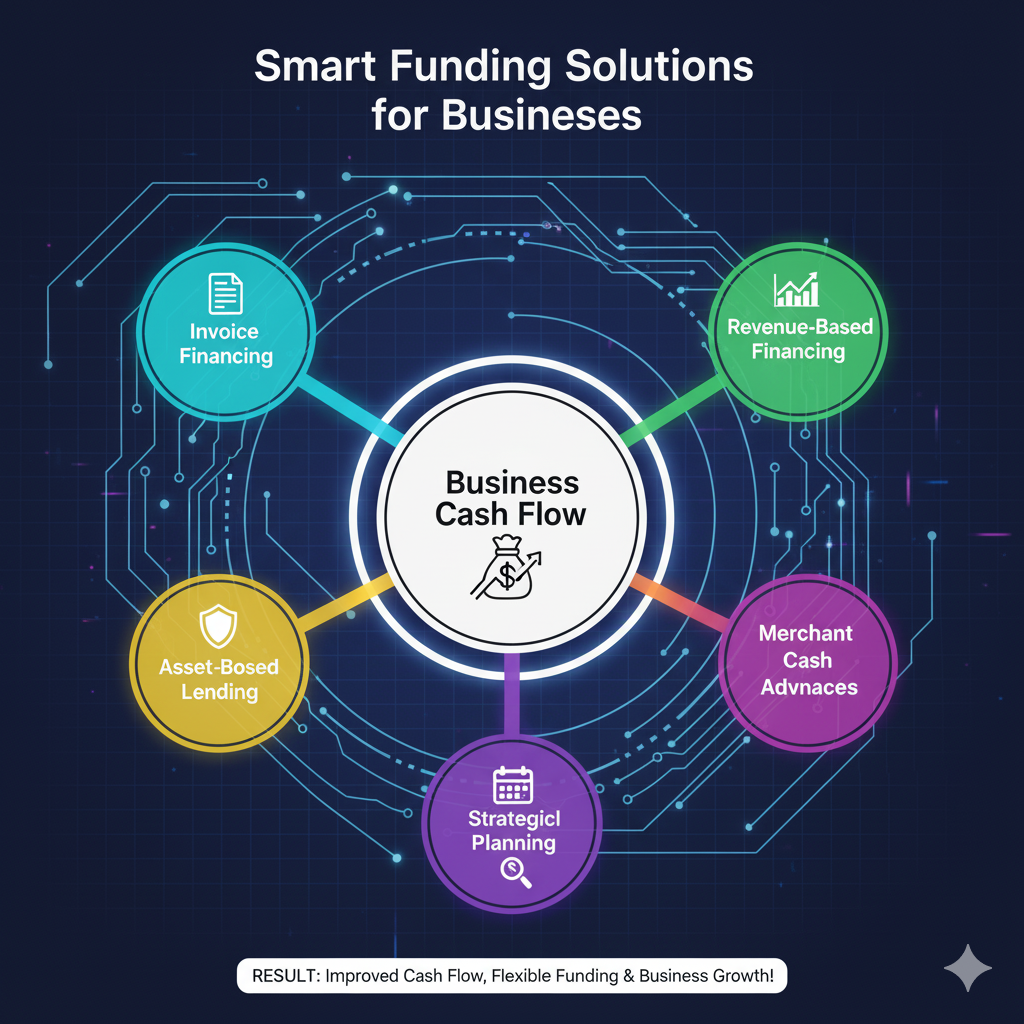Smart funding options that will change the way your business makes money
82% of businesses have trouble with cash flow, but many entrepreneurs still use old ways of getting money that cause more problems than they solve. The financial world has changed a lot, and now there are new options that work with your business’s rhythm instead of against it.
Businesses today need funding options that can change to fit their specific needs. When you apply for a traditional bank loan, you usually have to fill out a lot of paperwork, have a perfect credit score, and stick to strict repayment schedules that don’t always match your changing income. Newer funding options, on the other hand, look at your business’s past performance and future potential rather than just its past performance.
This in-depth guide looks at the best ways to get funding right now, helping you find ways to ease cash flow problems while still supporting long-term growth. We’ll look at how these ideas can be used in the real world, give you useful criteria for choosing, and talk about new trends that could change how businesses get money.
Understanding these smart funding options will help you make smart choices that will strengthen your business foundation, whether you’re dealing with seasonal changes, trying to grow quickly, or just looking for more flexible financial options.
Knowing the Basics of Cash Flow
The cash flow is what keeps any business running. It’s the flow of money in and out of your business that decides if you can pay your bills, employees, and suppliers on time.
Positive cash flow happens when your business gets more money than it spends in a certain amount of time. This healthy state allows for reinvestment, growth opportunities, and financial stability. When expenses are higher than income, this is called negative cash flow. This puts pressure on the business that can quickly turn into big problems.
How important it is to manage cash flow
Managing your cash flow well has a direct effect on whether or not your business will survive and grow. Companies that are good at managing their cash flow are 30% more likely to get good financing terms and 40% better at getting through tough economic times.
Poor cash flow management creates a domino effect. Late payments to suppliers hurt relationships, missed payroll hurts employee morale, and not having enough working capital limits growth opportunities. These problems add up quickly, making it harder and harder to get back on track.
Knowing how your cash flow works can help you figure out the best time to make funding decisions. For example, businesses that only make money during certain times of the year might need different solutions than businesses that make money every month.
Limitations of Traditional Funding
For decades, bank loans have been the main way to get money, but they come with a lot of restrictions that modern businesses find more and more difficult to deal with.
The Pros and Cons of Bank Loans
To get a traditional bank loan, you need to provide a lot of paperwork, such as three years’ worth of financial statements, detailed business plans, and thorough credit checks. This choice isn’t good for urgent cash flow needs because it usually takes 30 to 90 days to get approved.
Banks also set strict repayment schedules that don’t change based on how much money your business makes. During slow times, a retail business still has to make the same monthly payments, which could make cash flow problems worse.
Another problem is the need for collateral. A lot of loans need personal guarantees or business assets as collateral, which can put entrepreneurs’ personal finances at risk.
Problems with Lines of Credit
Business lines of credit are more flexible than regular loans, but they still depend a lot on your credit score and your relationship with your bank. Interest rates change depending on the state of the market, which makes it hard to plan for the long term.
Banks often cut or freeze credit lines when the economy is uncertain, which is when businesses need money the most. Because of this uncertainty, lines of credit aren’t good for making plans.
Smart funding options that are revolutionary
Modern funding solutions look at business performance metrics instead of traditional credit criteria. This opens up new options for companies that don’t fit the mold of traditional borrowers.
Invoice Financing: Speeding Up Your Revenue Cycle
With invoice financing, you can get paid right away for unpaid bills. Usually, you’ll get 80–90% of the bill’s value within 24–48 hours.
This solution particularly benefits B2B companies with long payment cycles. You get the money right away instead of having to wait 30 to 90 days for customers to pay you. The financing company collects from your customers directly.
Main benefits:
- No new debt on your balance sheet
- Decisions about credit based on how creditworthy your customers are
- Funding that grows with your business and is easy to get more of
- No set monthly payments
Invoice financing is a great way for service-based businesses, manufacturers, and distributors that send invoices to other businesses on a regular basis to get money.
Revenue-Based Financing: Flexible Growth Capital
With revenue-based financing, you get money up front in exchange for a percentage of your future income until you pay back a set amount. This new way of doing things links the cost of funding to how well a business does.
Unlike regular loans, your payments change based on how much money you make. You pay more when business is good and less when business is slow. This flexibility prevents cash flow strain during natural business cycles.
Some benefits are:
- No personal guarantees needed
- Payments change based on how well the business does.
- The approval process is faster than for regular loans.
- No loss of equity
Companies that make money in a predictable way, like technology companies and subscription-based businesses, really like this option.
Asset-Based Lending: Using Your Assets to Get Money
With asset-based lending, you can borrow money using your business’s assets, like its inventory, equipment, or accounts receivable, as collateral. This method looks at the value of the assets instead of the credit score or cash flow history.
Companies that make things and have a lot of inventory or equipment can get a lot of money this way. The amount of money that can be borrowed is usually between 70 and 85 percent of the value of the assets that are eligible.
Merchant Cash Advances: Quick Cash for Service-Based Businesses
Merchant cash advances provide quick funding in exchange for a portion of future credit card sales. They cost more than other options, but they give you quick access to money with few requirements.
This solution works well for restaurants, stores, and service businesses that take credit cards on a regular basis. Daily credit card sales automatically pay off the debt, so there are no monthly payments to make.
Success Stories in the Real World
Understanding how other businesses have successfully implemented smart funding solutions provides valuable insights for your own decision-making process.
Case Study: Changing a Manufacturing Company
A medium-sized manufacturer had trouble with cash flow during the holidays because they had to keep a lot of extra inventory. Their ability to pay back loans changed over time, so traditional bank loans didn’t work for them.
They used invoice financing for their B2B sales and revenue-based financing for money to grow. Invoice financing gave them instant working capital, and revenue-based financing paid for new equipment.
Results: 35% more stable cash flow, 25% lower funding costs, and a successful move into two new markets in 18 months.
Case Study: Growth of a Tech Startup
A software-as-a-service company needed money to grow, but it didn’t want to give up any of its ownership. Because there wasn’t enough collateral and the business hadn’t been around for long, they couldn’t get traditional loans.
They decided on revenue-based financing, which uses steady subscription revenue as the basis for funding. The flexible repayment plan let them spend a lot of money on getting new customers when business was good and less money when business was slow.
Outcome: 200% revenue growth over two years, successful market expansion, and full ownership of the company.
Case Study: Growing a Service Business
A professional services company grew quickly, but it had trouble with clients who took a long time to pay. Invoices that weren’t paid often totaled more than $200,000, which made it hard to get enough working capital.
Invoice financing gave businesses immediate access to 85% of the value of their invoices, which made it much easier to predict cash flow. This gave them the money they needed to hire more people, spend more on marketing, and take on bigger projects without worrying about cash flow.
Effect: 50% more employees, 40% more revenue, and happier clients thanks to better service delivery.

Choosing the Best Way to Get Money
To choose the best funding option, you need to carefully consider your business’s needs, goals, and financial situation.
Looking at Your Business Profile
Look at how your income changes over time. Companies that make the same amount of money every month might need different solutions than those that only make money during certain times of the year or those that are growing quickly.
Think about your customers and how they pay. Invoice financing is often best for B2B companies that have long payment cycles, but businesses that need to collect payments right away might prefer other options.
Look at your stage of growth. Established businesses with a track record of success have more ways to get money than startups do. However, newer, more creative solutions often focus on helping new businesses.
Evaluating Financial Need
Find out if you need money for short-term operations or long-term growth. Different types of funding work better for different situations, so it’s important to find the right one for your needs.
Take into account all fees, interest rates, and repayment terms to figure out the real cost of borrowing money. Some options may seem more expensive at first, but their flexibility could make them a better overall value.
Assessment of Risk Tolerance
Think about how much power you’re willing to give up. Most of the time, revenue-based financing doesn’t require giving up equity. Some funding options, on the other hand, might require you to oversee the business or have a say in decisions.
Think about how comfortable you are with payments that change. Many businesses benefit from flexible repayment plans, but they need to be sure that their income will be steady.
Guidelines for Implementing Strategy
To get the most benefits and the least risks from smart funding, you need to plan and carry it out carefully.
When to Apply for Funding
Before you really need the money, apply for it. Most smart funding options get approved faster than regular loans, but it’s better to have money ready before a crisis so you can negotiate better and make better decisions.
If they apply to your business, think about seasonal factors. Getting funding during times of strong performance often leads to better terms and more approvals.
Documentation and Preparation
Smart funding options usually don’t need as much paperwork as regular loans, but it’s still important to be ready. Organize financial statements, cash flow projections, and business performance metrics.
Many alternative lenders use technology to evaluate applications, so having accurate financial information is very important for getting the best terms and approval rates.
Making connections with lenders
Before you need money, make connections with more than one source of funding. This method gives you choices when you need them and lets you shop around for the best terms.
Some lenders give better rates to businesses or customers who keep coming back.
What the Future Holds for Business Funding
Technology improvements and changing business needs are making the funding landscape change quickly.
Automated underwriting and artificial intelligence
AI-powered lending platforms can look over loan applications in a matter of minutes instead of days or weeks. These systems look at hundreds of pieces of data, such as reviews on the internet, social media presence, and real-time financial performance.
This technology growth will probably make it easier to get funding while also lowering costs and speeding up the approval process.
Solutions for Embedded Finance
More and more, financial services are built right into business software platforms. Accounting software might let you borrow money against your invoices, and e-commerce platforms might give you working capital based on how well your sales are doing.
This integration makes it easier to get funding and offers more personalized solutions based on real business data.
Funding that is linked to sustainability
More and more, environmental and social responsibility factors are affecting how money is given. Companies that show they are environmentally friendly may be able to get better funding terms or special green financing options.
Apps for cryptocurrency and blockchain
Digital currencies and blockchain technology enable new funding mechanisms, including decentralized finance (DeFi) solutions and cryptocurrency-backed lending.
These options are still new, but they could give tech-savvy businesses that are comfortable with digital financial tools more choices.
Getting the Most Out of Your Funding
Smart funding isn’t just about getting money; it’s also about making long-term financial plans that will help your business succeed.
Making yourself financially strong
Don’t rely too much on one source of funding; instead, use a variety of them. Mixing different types of funding makes you more flexible and lowers your risk.
Keep good financial records and check on your performance on a regular basis. Using data to make funding decisions leads to better results and stronger relationships with lenders.
Strategic Growth Planning
Use flexible funding to go after chances that traditional loans might not be able to help with. For example, revenue-based financing lets you make big marketing investments that could make it hard to keep up with fixed payments.
Think about when to get funding in relation to your growth goals. Some types of funding are better for quick growth, while others are better for steady, long-term growth.
Monitoring performance
Keep an eye on the key performance indicators that lenders use to judge you. Knowing these numbers will help you get the best funding terms for your business.
Regular checks on your financial health can help you find problems before they get worse, which keeps your options for getting money open.
This is where you make smart financial choices.
Businesses that are willing to look beyond traditional banking relationships have never had so many chances to get funding. Smart funding solutions work with the way your business runs, giving you money when you need it and keeping your cash flow steady during tough times.
To be successful, you need to know what your business needs, carefully look at all your options, and use solutions in a smart way. The businesses that are doing well right now are the ones that are using these new ways of getting money to grow while still being able to change their finances.
Business Kiwi’ main job is to help businesses make sense of these complicated funding choices. Our team of experts looks at your unique situation, finds the best ways to get funding, and helps you put those plans into action to make your finances stronger.
Are you ready to change how you manage your cash flow? Today, set up a meeting with one of our funding experts to learn how smart funding solutions can help your business grow faster and ease your financial worries. Your business should have access to funding options that work just as hard as you do.







